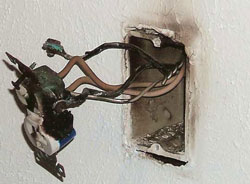Phone or Text Fairfield Electric
Mail: 632-A Wilson Street
Victoria BC V9A 3H2
Aluminum Wiring
Aluminum wire is safe when used in the right application and if it is correctly installed and maintained.
You can determine if your house is wired with aluminum by looking at the wiring, either between open floor joists in the basement, up in the attic, or at the service panel. If the wiring is aluminum and was manufactured before May 1977, the outer covering of the cable will be marked, at least every 12 inches, with the word ALUMINUM, or an abbreviation, ALUM, or AL. If the cable was manufactured after May 1977, the marking may be ALUMINUM ACM, ALUM ACM, or ALACM.
You can call Fairfield Electric (250)-885-1227 and request a service call to confirm if there is aluminum wiring at your place and if so, how much of the wiring in aluminum.
In our experience, aluminum seems to be present in most, perhaps all small family homes built in the 70’s here in Victoria BC. Aluminum wiring is legal, complies with the Electrical Code, and is still used in many aspects of wiring.
The BC Safety Authority estimates that there are over 450,000 homes in Canada wired entirely with aluminum wiring. Most of these homes were built in the 1960’s to late 1970’s. Problems began to surface where aluminum was used in branch circuit wiring. These are the smaller wires that bring electricity from the electrical panel to the plugs, switches and lights.
Aluminum tends to oxidize when exposed to air, resulting in connections overheating. Aluminum is not as resilient as copper and also has a higher rate of expansion, which can cause loose terminations and connections, at times resulting in arcing, melting and even fire. Breakage, due to improper stripping of the wires or over-tightening of the splices during the installation stage, creates further problems. Insurance companies are wary of homes with aluminum wiring and most companies require a complete electrical safety inspection by a trained and certified electrical contractor (like Fairfield Electric). Electrical modifications are usually needed and in some cases complete rewiring is recommended to reduce the risk of a house fire.

This photo shows an overheated outlet we found on a routine service call in James Bay.
A routine procedure to make aluminum wiring safe is called Pigtailing. An aluminum-to-copper transition pigtail is spliced into every outlet, switch, light fixture and hard-wired appliance in the house. This work is minimally invasive, meaning there is no dust or loud noise involved. Time involved might be two days for a 2,000 square foot 2-bedroom house. Cluttered houses take longer.
According to the US Consumer Product Safety Commission “Homes wired with aluminum wire manufactured before 1972 are 55 times more likely to have one or more connections reach Fire Hazard Conditions than is a home wired with copper.”
If you suspect that your house is wired with aluminum, Fairfield Electric Instant Service can inspect it and advise you. We often recommend checking the splices and connections to confirm they were made correctly, and we can resplice and make aluminum to copper transitions quickly and cheaply, and in most cases without having to shut off power to the entire house.
Any evidence of overheating around wiring, switching, appliances, fixtures should be investigated as soon as possible.
You can see a BC Safety Authority page that mentions aluminum wiring safety HERE
Here is a link to New York Times article that deals with the subject in some depth.
Call (250) 885-1227 to speak to an electrician now.

You must be logged in to post a comment.